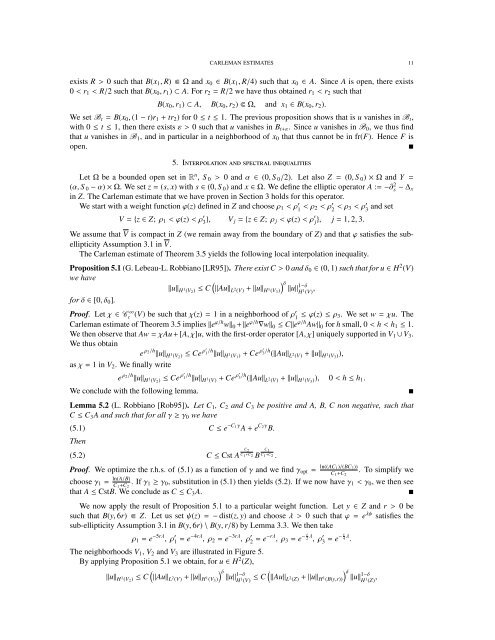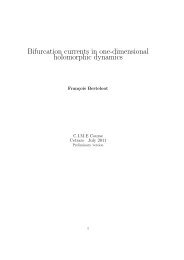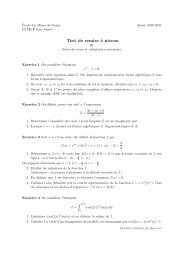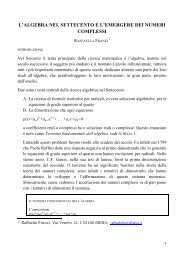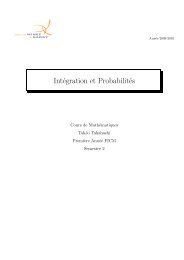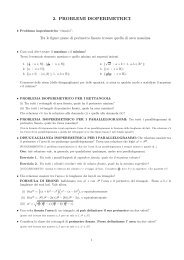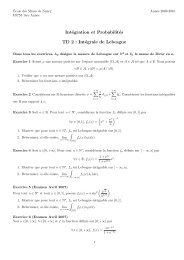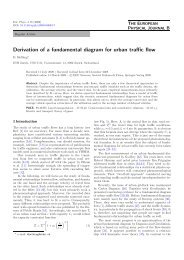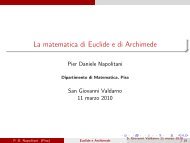on carleman estimates for elliptic and parabolic operators ...
on carleman estimates for elliptic and parabolic operators ...
on carleman estimates for elliptic and parabolic operators ...
You also want an ePaper? Increase the reach of your titles
YUMPU automatically turns print PDFs into web optimized ePapers that Google loves.
CARLEMAN ESTIMATES 11<br />
exists R > 0 such that B(x 1 , R) ⋐ Ω <strong>and</strong> x 0 ∈ B(x 1 , R/4) such that x 0 ∈ A. Since A is open, there exists<br />
0 < r 1 < R/2 such that B(x 0 , r 1 ) ⊂ A. For r 2 = R/2 we have thus obtained r 1 < r 2 such that<br />
B(x 0 , r 1 ) ⊂ A, B(x 0 , r 2 ) ⋐ Ω, <strong>and</strong> x 1 ∈ B(x 0 , r 2 ).<br />
We set B t = B(x 0 , (1 − t)r 1 + tr 2 ) <strong>for</strong> 0 ≤ t ≤ 1. The previous propositi<strong>on</strong> shows that is u vanishes in B t ,<br />
with 0 ≤ t ≤ 1, then there exists ε > 0 such that u vanishes in B t+ε . Since u vanishes in B 0 , we thus find<br />
that u vanishes in B 1 , <strong>and</strong> in particular in a neighborhood of x 0 that thus cannot be in fr(F). Hence F is<br />
open.<br />
<br />
5. INTERPOLATION AND SPECTRAL INEQUALITIES<br />
Let Ω be a bounded open set in R n , S 0 > 0 <strong>and</strong> α ∈ (0, S 0 /2). Let also Z = (0, S 0 ) × Ω <strong>and</strong> Y =<br />
(α, S 0 − α) × Ω. We set z = (s, x) with s ∈ (0, S 0 ) <strong>and</strong> x ∈ Ω. We define the <strong>elliptic</strong> operator A := −∂ 2 s − ∆ x<br />
in Z. The Carleman estimate that we have proven in Secti<strong>on</strong> 3 holds <strong>for</strong> this operator.<br />
We start with a weight functi<strong>on</strong> ϕ(z) defined in Z <strong>and</strong> choose ρ 1 < ρ ′ 1 < ρ 2 < ρ ′ 2 < ρ 3 < ρ ′ 3<br />
<strong>and</strong> set<br />
V = {z ∈ Z; ρ 1 < ϕ(z) < ρ ′ 3 }, V j = {z ∈ Z; ρ j < ϕ(z) < ρ ′ j }, j = 1, 2, 3.<br />
We assume that V is compact in Z (we remain away from the boundary of Z) <strong>and</strong> that ϕ satisfies the sub<strong>elliptic</strong>ity<br />
Assumpti<strong>on</strong> 3.1 in V.<br />
The Carleman estimate of Theorem 3.5 yields the following local interpolati<strong>on</strong> inequality.<br />
Propositi<strong>on</strong> 5.1 (G. Lebeau-L. Robbiano [LR95]). There exist C > 0 <strong>and</strong> δ 0 ∈ (0, 1) such that <strong>for</strong> u ∈ H 2 (V)<br />
we have<br />
‖u‖ H 1 (V 2 ) ≤ C ( ) δ<br />
‖Au‖ L 2 (V) + ‖u‖ H 1 (V 3 ) ‖u‖<br />
1−δ<br />
<strong>for</strong> δ ∈ [0, δ 0 ].<br />
Proof. Let χ ∈ C ∞<br />
c (V) be such that χ(z) = 1 in a neighborhood of ρ ′ 1 ≤ ϕ(z) ≤ ρ 3. We set w = χu. The<br />
Carleman estimate of Theorem 3.5 implies ‖e ϕ/h w‖ 0 +‖e ϕ/h ∇w‖ 0 ≤ C‖e ϕ/h Aw‖ 0 <strong>for</strong> h small, 0 < h < h 1 ≤ 1.<br />
We then observe that Aw = χAu + [A, χ]u, with the first-order operator [A, χ] uniquely supported in V 1 ∪ V 3 .<br />
We thus obtain<br />
e ρ 2/h ‖u‖ H 1 (V 2 ) ≤ Ce ρ′ 1 /h ‖u‖ H 1 (V 1 ) + Ce ρ′ 3 /h (‖Au‖ L 2 (V) + ‖u‖ H 1 (V 3 )),<br />
as χ = 1 in V 2 . We finally write<br />
H 1 (V) ,<br />
e ρ 2/h ‖u‖ H 1 (V 2 ) ≤ Ce ρ′ 1 /h ‖u‖ H 1 (V) + Ce ρ′ 3 /h (‖Au‖ L 2 (V) + ‖u‖ H 1 (V 3 )), 0 < h ≤ h 1 .<br />
We c<strong>on</strong>clude with the following lemma.<br />
Lemma 5.2 (L. Robbiano [Rob95]). Let C 1 , C 2 <strong>and</strong> C 3 be positive <strong>and</strong> A, B, C n<strong>on</strong> negative, such that<br />
C ≤ C 3 A <strong>and</strong> such that <strong>for</strong> all γ ≥ γ 0 we have<br />
(5.1) C ≤ e −C 1γ A + e C 2γ B.<br />
Then<br />
(5.2) C ≤ Cst A C 2<br />
C 1 +C 2 B C 1<br />
C 1 +C 2 .<br />
Proof. We optimize the r.h.s. of (5.1) as a functi<strong>on</strong> of γ <strong>and</strong> we find γ opt = ln((AC 1)/(BC 2 ))<br />
C 1 +C 2<br />
. To simplify we<br />
choose γ 1 = ln(A/B)<br />
C 1 +C 2<br />
. If γ 1 ≥ γ 0 , substituti<strong>on</strong> in (5.1) then yields (5.2). If we now have γ 1 < γ 0 , we then see<br />
that A ≤ CstB. We c<strong>on</strong>clude as C ≤ C 3 A.<br />
<br />
We now apply the result of Propositi<strong>on</strong> 5.1 to a particular weight functi<strong>on</strong>. Let y ∈ Z <strong>and</strong> r > 0 be<br />
such that B(y, 6r) ⋐ Z. Let us set ψ(z) = − dist(z, y) <strong>and</strong> choose λ > 0 such that ϕ = e λψ satisfies the<br />
sub-<strong>elliptic</strong>ity Assumpti<strong>on</strong> 3.1 in B(y, 6r) \ B(y, r/8) by Lemma 3.3. We then take<br />
ρ 1 = e −5rλ , ρ ′ 1 = e−4rλ , ρ 2 = e −3rλ , ρ ′ 2 = e−rλ , ρ 3 = e − r 2 λ , ρ ′ 3 = e− r 4 λ .<br />
The neighborhoods V 1 , V 2 <strong>and</strong> V 3 are illustrated in Figure 5.<br />
By applying Propositi<strong>on</strong> 5.1 we obtain, <strong>for</strong> u ∈ H 2 (Z),<br />
‖u‖ H 1 (V 2 ) ≤ C ( ) δ<br />
‖Au‖ L 2 (V) + ‖u‖ H 1 (V 3 ) ‖u‖<br />
1−δ<br />
H 1 (V) ≤ C ( ) δ<br />
‖Au‖ L 2 (Z) + ‖u‖ H 1 (B(y,r)) ‖u‖<br />
1−δ<br />
H 1 (Z) ,


